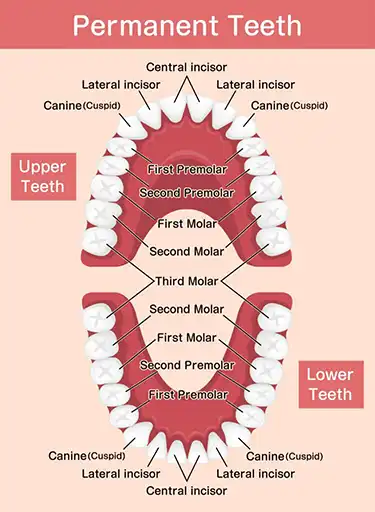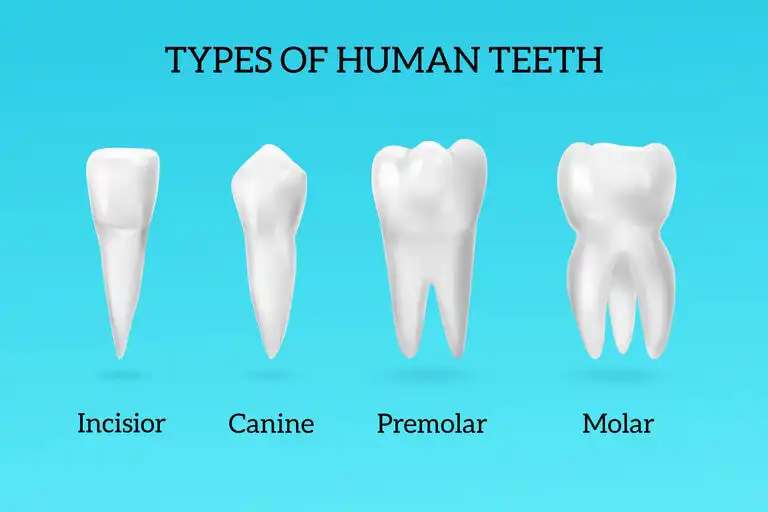Teeth like all parts of human body have unique characteristics with each teeth carries its name and function. The structure of teeth is divided into mainly hard tissues and soft tissue. Hard tissues include enamel, dentin and cementum (the calcified or mineralized connective tissue that covers the tooth’s roots and connects the tooth to the alveolar bone). Soft tissue is the pulp, which has the role of providing both nerve and blood to the teeth. Let’s learn more about our different types of teeth and what they serve.
Primary teeth and permanent teeth
Teeth are complex structures and are developing through different ages and even before the birth in an individual. The first teeth that you see in a baby’s mouth are called primary teeth or baby teeth. This is when baby teething stage has started where most babies get their first teeth when they are 6 months old. Even in the utero, primary teeth are in formation in 14 week of utero and this formation goes into a complete stage after birth until 3 years of the baby’s age.

There is another stage of children’s teeth stages that is called mixed dentition. It is the time of the appearance of the first permanent teeth that is when children are 6 years old and the time of falling one by one of the primary teeth.
The last stage of the teeth growth and eruption is called the permanent teeth period. The permanent teeth development can extend into 12 and 15 years of age to be in complete formation. For the eruption of third molars in some people we should even wait to get to 25 years old.
Differences between primary and permanent teeth
There are some differences between primary and permanent teeth apart from the time of eruption and periods of complete formation.
- The pulp size in primary teeth is larger as we compare it with the size of the crown.
- The lighter and whiter color is a common feature of the baby teeth.
- The enamel and dentin that are hard tissue structures of teeth are thinner than that of the permanent teeth.
- Crown of teeth in baby teeth is smaller.
- There are more differences in roots and size of different teeth with tooth surface such as in primary molar teeth.
The number of teeth
If we divide the teeth by a symmetrical line, it is reasonable to divide them in both upper jaw (maxillary) and lower jaw (mandibular) and start with the median line, which is noticeable in most people. The median line separates the central incisors.
In each side of this line, we have dental arch. In a normal dental condition, there are 10 teeth in right or left of the arch both in upper and lower jaws in primary teeth. So, in total, there are 20 primary teeth if no dental problems like trauma, missing teeth (hypodontia), and other factors exist.
The number of permanent teeth is 16 in each side of the arch both upper and lower teeth and in total 32 permanent teeth.
Types of teeth and their names
Teeth have names that we can call by. The names are associated with the functions that these teeth serve. There are 3 main names: incisor, canine and molar. Premolar is also the name for added permanent teeth that appear in permanent teeth period.

Incisors
These are the first teeth that you can see in the baby teeth eruption stages, which have been completely erupted by 16 months of baby’s age. Incisors are the series of anterior teeth in front including lateral and central teeth. Those in the center are called central incisors and the next to these centrals are called lateral incisors.
There are 2 upper/lower central incisors and 2 upper/lower lateral incisors in both primary and permanent teeth. In total, there are 8 incisors in the mouth. As the name suggests, these teeth have sharp incisors surface to function as biting and cutting foods.
Canines
With the name also showing similarity, humans have canine teeth similar to what dogs or other carnivorous animals have. There are 4 canine teeth in the upper and lower arches. Canine teeth have pointed shape or cusps and they are longer than other teeth.
Canines are clear to see and spot. These are the third teeth from the median line in the symmetrical line we discussed. From the cosmetic point of view, canines are really important teeth. The function of the canine teeth can include food tearing and stability of teeth in the mouth due to the unique position of the canines in the dental arch.
Premolars
There are 4 premolar teeth in upper jaw and 4 in the lower jaw. In total, there are 8 premolars in the mouth. Premolars consist of first premolar (right next to canine teeth) and second premolar (right in front of molar teeth).
Premolar teeth are between canines and molars. First premolar teeth help canine in tearing the food and are to some extent similar in function in that. Second premolars function as grinding like molars but not with full grinding capabilities like molar teeth.
There are no premolars in the primary dentition and they show up in the permanent teeth, replacing the molars in primary dentition.
Molars
If you look at the back of the mouth, you see the posterior teeth with many cusps (curves) on the surface of the teeth. Molar teeth are the largest in dental arch. Both upper (maxillary) and lower (mandibular) jaw have total number of 12 teeth, 6 upper and 6 lower, 3 in either side of the arch.
The function of the molar teeth includes much of the chewing process (mastication) and making the foods into smaller pieces. Premolars have cusps to make the occlusion fit and food cutting and grinding easier. There are mainly 4 or 5 cusps in a molar tooth, a key factor in chewing work as well as occlusion and how teeth align.
Molar teeth consist of first molar (next to second premolar), second molar, and wisdom teeth or third molar. Wisdom teeth are the most posterior of the three and may not have enough room to develop normally in some people.
